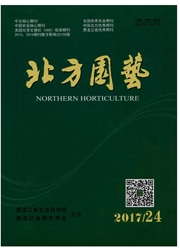

 中文摘要:
中文摘要:
以娃娃菜和西芹为试材,根据2种蔬菜生长周期,研究了娃娃菜与西芹间作、娃娃菜单作和西芹单作不同模式下的2种蔬菜个体生长及产量差异,对比分析了不同间作模式和单作模式下的经济效益及产值。结果表明:2垄娃娃菜间作1垄西芹种植模式的总产量,较娃娃菜单作或西芹单作增加了10.15%和1.90%,经济效益提高了3.83%和15.26%,经济效率提高了3.82%和15.30%。说明2垄娃娃菜间作1垄西芹种植模式为最佳,产值为10 704.77元,经济效率为16.05元·m-2。
 英文摘要:
英文摘要:
Mini Chinese cabbage and celery were used as test materials.Based on the different growth periods of two kinds of vegetables,the difference of individual growth and yield of two kinds of vegetables under the different intercropping planting models of mini Chinese cabbage and celery intercropping group,sole crop mini Chinese cabbage and sole crop celery were studied,the economic benefits and the value of different intercropping models and monoculture mode were compared and analyzed.The results showed that the total production of mini Chinese cabbage and celery of the intercropping planting mode of two lines mini Chinese cabbage and one line celery were increased by 10.15%and 1.90%than sole crop mini Chinese cabbage or celery,the economic benefits were increased by 3.83% and 15.26%,the economic efficiency were increased by 3.82% and 15.30%.In summary,the intercropping planting mode of two lines mini Chinese cabbage and one line celery was the best,the667m^2 value reached 10 704.77 RMB and economic efficiency was up to 16.05RMB·m^-2.
 同期刊论文项目
同期刊论文项目
 同项目期刊论文
同项目期刊论文
 期刊信息
期刊信息
